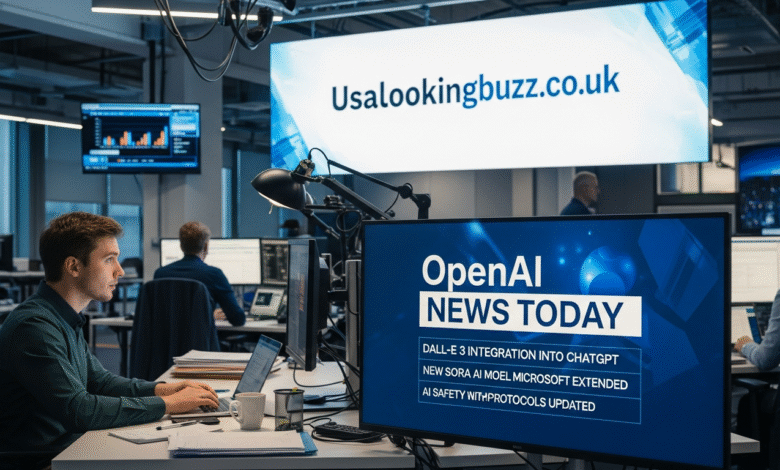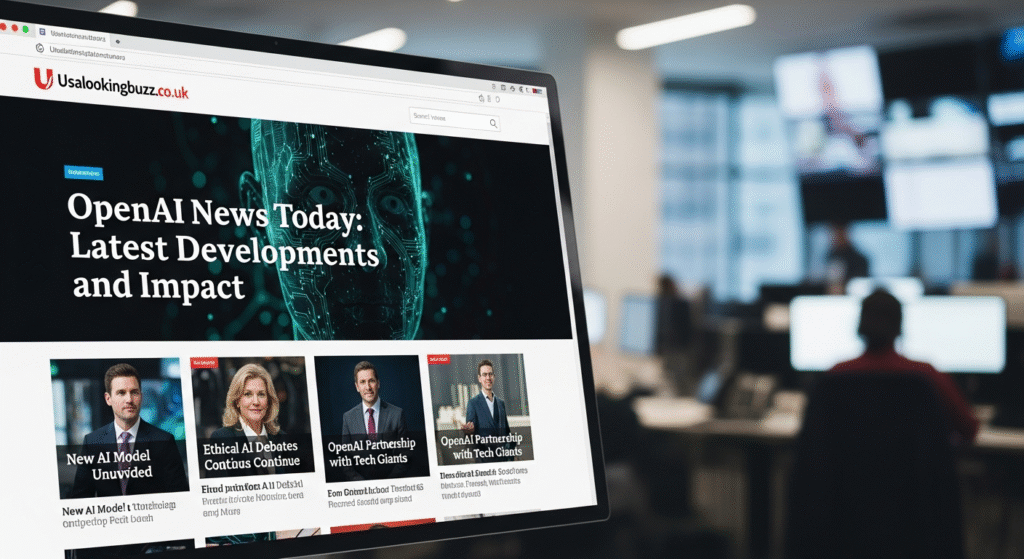Breaking OpenAI News Today Reveals Game-Changing Partnerships

Introduction
The OpenAI News Today just got a major shake up. If you have been following tech developments lately, you know OpenAI has been making headlines consistently. OpenAI News Today brings another massive announcement that is reshaping how we think about AI infrastructure and the future of this rapidly evolving industry.
OpenAI has signed a groundbreaking deal to purchase $38 billion worth of cloud computing capacity from Amazon Web Services over the next seven years. This partnership represents the ChatGPT creator’s first major collaboration with AWS. It signals a dramatic shift in the company’s approach to scaling its ambitious AI projects.
The timing could not be more significant. This announcement comes less than a week after OpenAI restructured its partnership with Microsoft, clearing a path for more growth and a potential IPO. You are witnessing a pivotal moment in tech history. These developments will likely influence how artificial intelligence evolves over the coming years.
OpenAI News Today: The $38 Billion AWS Partnership
Let me break down what this massive deal actually means. Under this new agreement, OpenAI is accessing AWS compute comprising hundreds of thousands of state of the art Nvidia GPUs, with the ability to expand to tens of millions of CPUs to rapidly scale agentic workloads. That is an incredible amount of computing power.
The partnership started immediately. OpenAI will begin utilizing AWS compute right away, with all capacity targeted to be deployed before the end of 2026, and the ability to expand further into 2027 and beyond. This aggressive timeline shows just how urgent OpenAI’s infrastructure needs have become.
What makes this deal particularly interesting is the technology involved. OpenAI will use Nvidia’s latest GB200 and GB300 chips, with both processors combining two graphics processing units with one central processing unit. These cutting edge processors will be deployed in specialized Amazon EC2 UltraServers designed specifically for AI workloads.
Sam Altman, OpenAI’s CEO, put it simply. He stated that scaling frontier AI requires massive, reliable compute, and the partnership with AWS strengthens the broad compute ecosystem that will power this next era. The company clearly believes this infrastructure is essential for achieving its ambitious goals.
Breaking Free from Microsoft Exclusivity
Here is something you need to understand about the broader context. The tech giant Microsoft was OpenAI’s sole cloud provider for about two years, but under the modified partnership, Microsoft no longer has the right of first refusal on OpenAI cloud contracts. This represents a fundamental shift in the relationship between these two AI powerhouses.
The restructuring happened just last week. It gives OpenAI much greater flexibility in securing the computing resources it needs from multiple providers. You might wonder why this matters so much. The answer lies in OpenAI’s explosive growth and its need for unprecedented amounts of computing power.
The deal is especially important for Amazon, which has been lagging behind in the AI cloud space compared to its big rivals such as Microsoft and Google. For AWS, this partnership validates its capabilities in the AI era. It demonstrates that the company can compete for the most demanding AI workloads in the industry.
The market certainly took notice. Amazon stock closed 4% higher on Monday, a record closing high for the stock, with the e-commerce giant up 14% over the last two trading days. That kind of market movement reflects investor confidence in the significance of this partnership.
Revenue Growth That Defies Expectations
Beyond infrastructure deals, OpenAI news today also includes remarkable insights into the company’s financial performance. Recent reports suggested OpenAI was generating around $13 billion in annual revenue. However, Altman quickly pushed back against those numbers.
During a recent podcast appearance, when asked about reports of $13 billion in revenue, Altman replied that the company is doing well more revenue than that. He seemed frustrated by what he viewed as conservative estimates that undervalue the company’s actual performance.
The revenue trajectory is steep. Last year, sources told the New York Times that OpenAI predicted revenue would hit $100 billion by 2029. That would represent astronomical growth from current levels. While some might view such projections skeptically, Altman and his team remain bullish about their prospects.
Altman acknowledged that revenue is growing steeply and explained that they are taking a forward bet that ChatGPT will keep growing, they will become one of the important AI clouds, and their consumer device business will be a significant thing. The company has multiple revenue streams in development beyond just ChatGPT subscriptions.
Of course, massive revenue does not automatically mean profitability. Microsoft on Wednesday reported a quarterly loss of roughly $4 billion that it attributed to its share of OpenAI’s losses. The company is spending enormous sums on research, development, and infrastructure. That spending will likely continue for years.

The Road to a Historic IPO
Perhaps the most exciting OpenAI news today involves the company’s potential initial public offering. OpenAI is reportedly quietly preparing for a potential IPO that could value the company at up to $1 trillion, which would become one of the largest in corporate history. Let that sink in for a moment. A trillion dollar valuation would be extraordinary.
The timeline remains somewhat uncertain. Sources told Reuters that OpenAI has begun internal groundwork to file with U.S. securities regulators as early as the second half of 2026, though the timeline could change depending on market conditions and the company’s financial performance. Nothing is set in stone yet, but the wheels are clearly in motion.
During a recent livestream, Altman addressed the IPO speculation directly. He acknowledged the possibility of an IPO for the first time, saying it is the most likely path for the company given the capital needs they will have. That statement represents a significant acknowledgment from someone who has historically been cautious about discussing such plans publicly.
Why would OpenAI go public? The answer is simple. Capital requirements. According to Gil Luria, managing director at D.A. Davidson, OpenAI will need to raise hundreds of billions of dollars over the next few years, with much of it coming in the form of debt. An IPO would provide access to public markets and potentially unlimited capital for future growth.
The company has also shown some frustration with critics. Altman said that although there are not many times when he wants OpenAI to be a public company, one of the rare times it is appealing is when critics are writing ridiculous posts about OpenAI going out of business, as he would love to tell them they could just short the stock. That combative tone suggests confidence in the company’s long term prospects.
Spending Commitments That Raise Questions
You might be wondering how sustainable all this growth really is. The numbers involved are staggering. OpenAI CEO Sam Altman has said the startup is committed to spending $1.4 trillion to develop 30 gigawatts of computing resources, enough to roughly power 25 million United States homes. That level of infrastructure investment is unprecedented in the tech industry.
The spending spree continues across multiple fronts. OpenAI’s overdraft continued its upward trajectory when the company signed the multi year $38 billion contract with AWS, which adds to the incremental $250 billion of Azure services it pledged to buy last week. These commitments total well over $1 trillion when you include deals with Oracle, Broadcom, Nvidia, and others.
Some analysts worry about sustainability. To some analysts, the increased investment from OpenAI and other tech giants signals that the industry is heading toward an AI bubble, wherein massive sums are spent beefing out an unproven technology with no clear sign of a meaningful return on investment. These are legitimate concerns worth considering.
However, supporters argue this spending is necessary. The race to develop artificial general intelligence requires resources on a scale we have never seen before. CEO Sam Altman has publicly discussed OpenAI’s chip needs, posting on social media that the company must figure out how to grow its GPU count from 1 million to 100 million. Whether that is literal or metaphorical, it illustrates the magnitude of what OpenAI is attempting.
Environmental and Energy Concerns
The environmental implications deserve attention too. The Lawrence Berkeley National Laboratory estimates that AI data centers will use up to 12 percent of US electricity by 2028. That is a massive amount of power consumption. It raises important questions about sustainability and environmental impact.
Public concern is growing. An AP/NORC poll from October found that 41 percent of Americans are extremely concerned about AI’s impact on the environment, while another 30 percent say they are somewhat concerned. These numbers suggest the industry will face increasing scrutiny over its energy usage and carbon footprint.
OpenAI and its partners will need to address these concerns. Companies are already investing in renewable energy and more efficient data center designs. However, the sheer scale of AI infrastructure growth means energy consumption will likely continue rising for the foreseeable future.
What This Means for the AI Industry
The ripple effects of today’s OpenAI news extend far beyond the company itself. The deal with Amazon shows OpenAI is eager to boost its computing capacity from anyone who can provide it. This multi vendor strategy could become the new normal for large AI companies that need diverse infrastructure sources.
Competition among cloud providers is intensifying. Amazon has also invested $8 billion in OpenAI competitor Anthropic, signaling Amazon’s push to anchor major AI startups on its infrastructure. Every major cloud provider wants to be the backbone for the next generation of AI development. The stakes could not be higher.
Microsoft still plays a crucial role despite the relationship changes. OpenAI will still be spending heavily with Microsoft, reaffirming that commitment by saying last week that it will purchase an incremental $250 billion of Azure services. This demonstrates that OpenAI is not abandoning its original partner but rather diversifying its infrastructure sources.
For investors and tech enthusiasts, these developments paint a picture of an industry in hypergrowth mode. The question is whether this growth is sustainable or whether we are witnessing the inflation of a bubble that will eventually burst. Time will tell, but the momentum right now is undeniable.
Looking Ahead: The Future of OpenAI
Where does OpenAI go from here? The company has set ambitious goals. OpenAI has clear goals to achieve artificial general intelligence, AI on par with human logic and reasoning, which is the Holy Grail of AI science. Achieving AGI would represent a breakthrough of historic proportions. It would fundamentally change society in ways we can barely imagine.
The infrastructure being built today lays the groundwork for that future. On November 2, 2025, OpenAI and Oracle revealed plans for the Stargate Project, a massive 1GW data center campus in Saline Township, Michigan, set to break ground in early 2026. These physical facilities will house the computing power needed for next generation AI research and development.
User adoption continues at a remarkable pace. ChatGPT became the fastest adopted application in digital history, reaching 100 million users in two months, with weekly active users soaring to 400 million by early 2025. That kind of growth creates both opportunities and challenges. The company must scale infrastructure to meet demand while continuing to innovate.
The path to AGI remains uncertain. As part of its latest agreement, OpenAI committed that any declaration of AGI be verified by an independent panel of experts, adding a layer of accountability. This safeguard addresses concerns about premature or misleading claims regarding breakthrough achievements in AI capabilities.

Conclusion
Today’s OpenAI news represents a turning point for the artificial intelligence industry. The $38 billion AWS partnership, combined with the restructured Microsoft relationship and preparations for a potential trillion dollar IPO, demonstrates the company’s aggressive growth strategy. These moves position OpenAI to compete at the highest levels of AI development.
The massive infrastructure investments show the company is betting big on its future. Whether these bets pay off remains to be seen. What is clear is that OpenAI is not slowing down. The company is doubling down on its mission to develop artificial general intelligence, regardless of the costs involved.
For you as a reader and potential stakeholder in this technology future, these developments matter. They will shape how AI evolves, how it gets deployed, and ultimately how it impacts your daily life. The decisions being made today by companies like OpenAI will echo for decades to come.
The AI race is on, and OpenAI just made several major moves to stay ahead. Whether this leads to transformative breakthroughs or unsustainable spending remains the trillion dollar question. One thing is certain though: the world is watching closely as this story continues to unfold.
What do you think about OpenAI’s massive infrastructure investments? Are they building the future or inflating a bubble? Share your thoughts and stay tuned for more updates as this rapidly evolving story develops.
FAQs
What is the biggest OpenAI news today?
OpenAI signed a $38 billion deal with Amazon Web Services to purchase cloud computing capacity over the next seven years, marking the company’s first major collaboration with AWS and providing access to hundreds of thousands of Nvidia GPUs. This partnership represents a significant shift in how OpenAI secures computing infrastructure.
When will OpenAI go public with an IPO?
OpenAI is reportedly preparing for a potential IPO that could happen by late 2026 or early 2027, though the timeline could change depending on market conditions and financial performance. CEO Sam Altman has acknowledged that an IPO is the most likely path forward, but no specific date has been set officially.
How much revenue is OpenAI generating?
While reports suggested around $13 billion in annual revenue, CEO Sam Altman stated the company is doing well more revenue than that figure. Sources previously indicated OpenAI predicted revenue would hit $100 billion by 2029, showing the company expects steep continued growth.
Why did OpenAI restructure its Microsoft partnership?
Microsoft was OpenAI’s sole cloud provider for about two years, but under the modified partnership announced last week, Microsoft no longer has the right of first refusal on OpenAI cloud contracts. This change gives OpenAI greater flexibility to source computing resources from multiple providers to meet its massive infrastructure needs.
How much computing power does OpenAI need?
CEO Sam Altman has publicly discussed that the company must figure out how to grow its GPU count from 1 million to 100 million. OpenAI is committed to spending $1.4 trillion to develop 30 gigawatts of computing resources, enough to roughly power 25 million United States homes.
What is OpenAI’s relationship with Amazon now?
OpenAI and AWS announced a multi year strategic partnership providing OpenAI with immediate access to AWS infrastructure for advanced AI workloads, representing a $38 billion commitment that will rapidly expand compute capacity over seven years. The partnership started immediately with deployment targets set for end of 2026.
Is OpenAI profitable?
No, OpenAI is currently losing money despite growing revenue. Microsoft reported a quarterly loss of roughly $4 billion that it attributed to its share of OpenAI’s losses. The company is spending enormous sums on infrastructure, research, and development as it pursues artificial general intelligence.
What environmental concerns surround OpenAI’s growth?
The Lawrence Berkeley National Laboratory estimates that AI data centers will use up to 12 percent of US electricity by 2028. An AP/NORC poll found that 41 percent of Americans are extremely concerned about AI’s impact on the environment, highlighting growing public awareness of the energy demands of AI infrastructure.
What is artificial general intelligence that OpenAI is pursuing?
Artificial general intelligence (AGI) is AI on par with human logic and reasoning, considered the Holy Grail of AI science. OpenAI has committed that any declaration of AGI will be verified by an independent panel of experts, adding accountability to prevent premature or misleading claims.
How fast has ChatGPT grown?
ChatGPT became the fastest adopted application in digital history, reaching 100 million users in two months, a milestone that took TikTok and Instagram far longer to achieve, with weekly active users soaring to 400 million by early 2025. This explosive growth has created unprecedented demands on OpenAI’s infrastructure and computing resources.
Also Read Usalookingbuzz.co.uk



